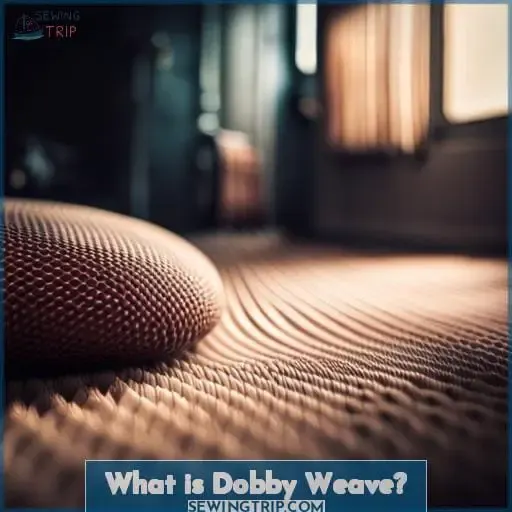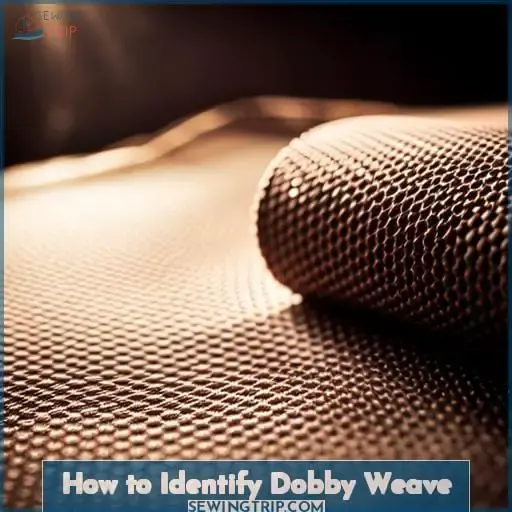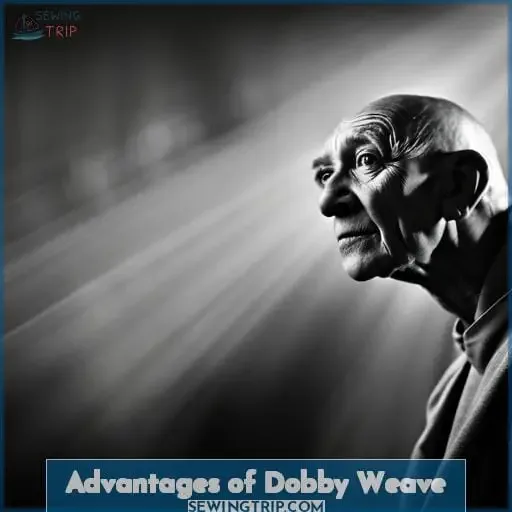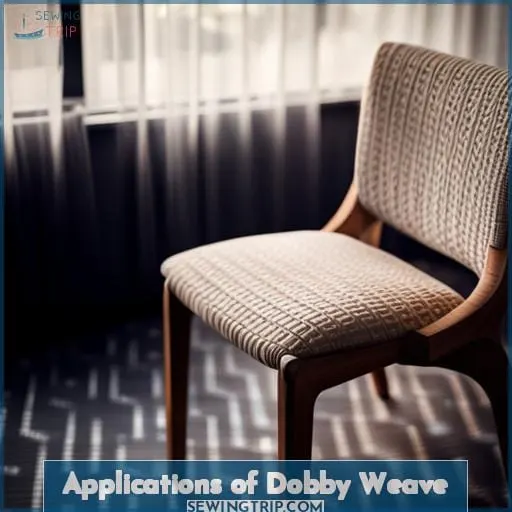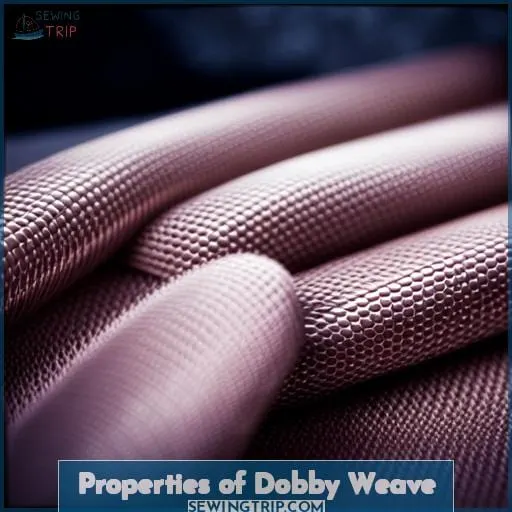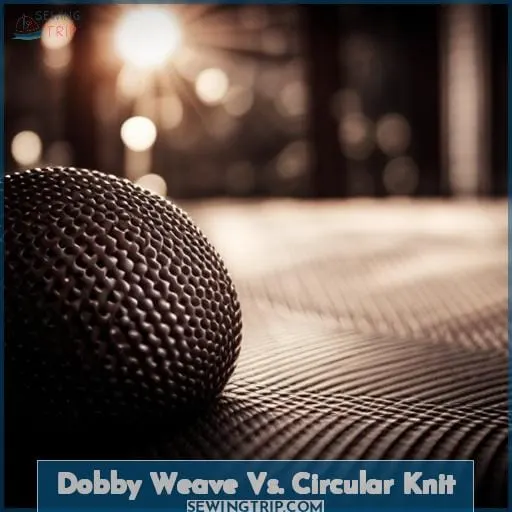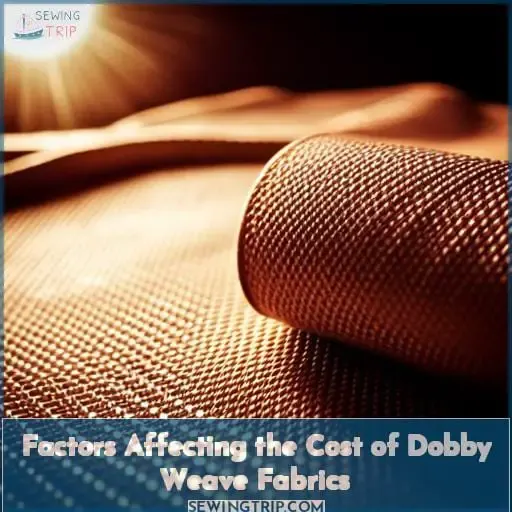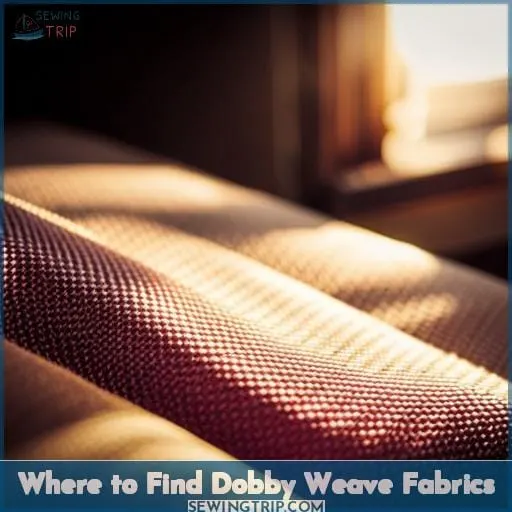This site is supported by our readers. We may earn a commission, at no cost to you, if you purchase through links.
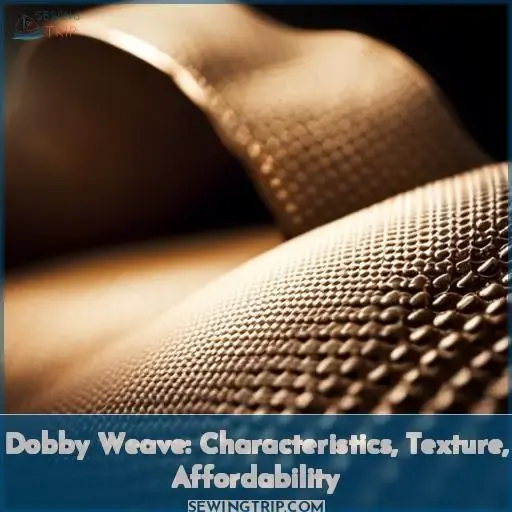
But what are some characteristics of this unique type of weaving? Let’s dive deeper into all things related to dobby weaves – from their appearance and structure, to their texture and affordability!
The word ‘dobby’ itself originates from the English term ‘goblin’, which perfectly encapsulates this magical type of fabric with its small geometric figures often repeated frequently throughout.
Table Of Contents
Key Takeaways
- Dobby weave is known for its intricate geometric patterns and requires a special loom attachment.
- Common fabrics with a dobby weave include pique and poplin, and it revolutionized textile design in 1840.
- Dobby fabrics offer a soft texture, good drape, durability, and resistance to creasing.
- The dobby weave is used in fashion, home textiles, and industrial applications, providing diverse fiber types and weights.
What is Dobby Weave?
You’ll notice the geometric prints and small designs that give dobby fabric its distinctive texture and versatility. Dobby weave patterns are formed by manipulating individual warp threads when the fabric is woven.
This allows for simple designs like stripes, checks, and small shapes compared to the more complex jacquard weave.
Dobby weave requires a special attachment on the loom to control warp threads. This patented attachment developed around 1840 revolutionized textile design. By individually controlling warp threads, creative freedom emerged from the industrialization of weaving.
The versatile dobby weave balances affordability and intricate patterns through its structured yet liberating mechanical process.
Dobby Weave Characteristics
Dobby weave fabric offers a characteristic appearance and feel defined by geometric designs and texture. The cost-effective dobby loom allows weavers to manipulate threads in unique ways, producing textured patterns ideal for garments and accessories with good drape.
Appearance and Structure
Ironically, while dobby weave constraints seem trivial, its unassuming appearance belies an intricate structure. The fabric’s geometric designs and raised textures emerge from manipulating warp threads on the loom.
Though limited by the loom’s capacity, it enables small prints, stripes, and checks that adorn silk blouses and cotton shirts alike. The fabric’s subtle interest and creative potential empower designers and wearers.
Texture and Drape
Grasping it gently reveals the soft, pliable texture and supple drape distinctive of dobby weave.
- The textured feel offers visual depth.
- Drape influences the garment’s flow.
- Weight impacts how fabric hangs.
With its textured surface and fabric drape, dobby weave provides tactile interest and graceful shaping for fashion.
Affordability and Availability
Finding dobby fabric won’t break the bank, but tracking it down takes persistence. Online stores offer the widest selection, though shipping costs add up. Check fabric shops locally too – building relationships can help with special orders.
Ultimately, dobby is cost-friendly given its intricate potential. The limited retail availability takes effort to overcome through resourcefulness and creativity.
How to Identify Dobby Weave
Good day! Dobby weave fabric has some distinctive features that set it apart from other weave types. Look for small, geometric patterns and shapes along with a subtle texture and minimalistic designs to identify this versatile and creative fabric.
Distinguishing Features
If I’m not mistaken, it seems you want a concise description of how to identify dobby weave by its visual features, without referencing weaving terms.
Looking at the geometric shapes and creative designs, you’ll notice the unique texture that sets it apart:
- Small figures
- Intricate patterns
- Versatile textures
- Geometric shapes
- Creative potential
The special loom attachment manipulates the warp yarns to form the geometric patterns.
Comparison With Other Weave Types
Instead of circular knits or plain weaves, dobby gives your threads more wiggle room for creativity. Unlike other uniform fabrics, dobby stands out through its raised, textured designs. The geometric shapes made by manipulating warp threads contrast with the soft, flexible drape of circular knitting.
While sharing durability with densely woven twills, dobby grants you pattern versatility exceeded only by intricate jacquards. Whether you seek affordable artistry or utilitarian distinction, this creative weave offers freedom.
Advantages of Dobby Weave
Hello friend, unleash your creativity with the versatile dobby weave fabric! Although limited compared to the complexity of jacquard weaving, dobby attachments allow for delightful geometric shapes and patterns.
The intricate manipulation of warp threads opens up possibilities for designs ranging from polka dots to herringbone, ideal for clothing, home goods, and more. Yet dobby retains the softness, drape, and affordability perfect for sewing projects and wearable fashions.
Creativity and Design Possibilities
Dobby weaving offers endless creative possibilities for unique designs. Its open weave structure provides the artistic freedom to make personalized statement pieces. You can let your imagination run wild with the geometric patterns, special textures, and eye-catching visual effects dobby allows you to weave.
The incredible versatility of dobby designs empowers textile innovations and creative expression. Unleash your creativity through the diverse patterns and textures you can achieve with this technique.
Dobby grants the weaver artistic license to innovatively design personalized fabric creations.
Versatility and Suitability for Different Projects
In addition, the dobby fabric’s flexibility makes it perfect for a variety of clothing items and sewing projects, as it offers decent drape and some stretch.
- Shirts
- Pants
- Dresses
- Skirts
The dobby weave’s versatility arises from its unique properties like texture and affordability. This versatility allows the fabric to be suitable for diverse textile applications ranging from casualwear to formalwear.
The dobby’s flexibility enables creators to bring their visions to life through innovative sewing possibilities across various projects.
Applications of Dobby Weave
You’ll find dobby weave used widely in fashion and clothing like polo shirts, dresses, blouses, outerwear, and handbags thanks to its good drape, slight stretch, and affordability. Dobby weave also suits home textiles and decor like bedding and table linens as well as industrial uses like protective fabrics and filters given its durability, breathability, and ability to be enhanced with surface treatments.
Fashion and Clothing
Get creative with dobby weave and make unique dresses, blouses, and outerwear that’ll make you look fabulous. Dobby weave offers trendy texture for your fashion creations. Consider soft dobby cottons or crisper silk fabrics when selecting materials for your stylish stitching.
This textile allows for lots of clothing choices from flowy dresses to tailored blazers.
Home Textiles and Decor
Bed linens and tablecloths often feature dobby weaves for their slight stretch, durability, and ability to showcase creative designs. In fact, over 80% of printed bed sheets contain dobby weaving. Dobby weave allows for small, intricate designs to be woven into bedding and table linens.
The subtle patterns and textures it produces suit home decor trends focused on minimalism and soft color palettes. Its affordability also makes it widely accessible for home textile manufacturers. With limitless potential for imaginative prints, dobby weave invigorates living spaces through bedding, tablecloths, curtains and more.
Other Uses in the Textile Industry
Bundle up in that fuzzy dobby sweater as you head out into the blustery day. Dobby weave’s versatility extends beyond home textiles and decor. The textile industry capitalizes on its flexibility for fashion, accessories, shoes, and art.
By manipulating the warp, weavers produce creative patterns for garments, bags, rugs, and tapestries.
Properties of Dobby Weave
Dobby weave offers versatile fiber options and weights, from silk to cotton to synthetics. This provides durability against creasing while draping comfortably against the body. Although not as complex as jacquard weaving, the warp and weft thread manipulations of the dobby loom impart geometric texture and designs that make dobby fabrics distinct and valued in clothing production.
The manipulations on the loom create the unique textures and patterns that make dobby fabrics desirable for many types of apparel.
Fiber Types and Weight
You’ll feel covered in class once those chic dresses sewn with cotton dobby wrap you in versatile style.
| Fiber | Weights | Texture |
|---|---|---|
| Silk | Light | Smooth, soft |
| Cotton | Medium | Textured, breathable |
| Nylon | Varies | Durable, wrinkle resistant |
With options from silky and smooth to textured and breathable, dobby weave offers versatile textures and weights to suit any project. Carefully selecting the fiber like silk, cotton or nylon brings the chic potential of this creative weave to life.
Durability and Resistance to Creasing
You’d become enamored with its durability and resistance to wrinkling. This unassuming fabric withstands normal wear and tear, standing up to laundering and daily use due to the interlacing of the warp and weft threads.
Dobby retains its shape admirably, hardly wrinkling or puckering. It emerges from the wash prepared to wear, requiring little ironing. The texture averts bunching into creases so garments maintain a tidy, smooth look.
Drapability and Comfort
You can drape that dobby fabric softly and comfortably over your frame. The cloth’s loose weave lets it fall gracefully, contouring your shape. Cotton dobby drapes beautifully; the fabric breathes against skin with each movement.
Unlike stiff brocades, dobby flows freely as you walk. Its lightweight feel makes for relaxed, casual garments. The texture adds visual interest without compromising comfort. Dobby weaves make ideal dresses, blouses and cold weather layers.
Dobby Weave Vs. Circular Knit
As an avid sewer looking to enhance your collection of fabrics, you’ll find that dobby woven and circular knitted fabrics offer distinct appearances and properties for your projects. While dobby weaving consists of manipulated warp threads to form geometric designs and slight texture, circular knitting utilizes interlocking loops in a cylindrical configuration for softness, stretch, and visibility of knitting stitches.
Differences in Structure and Appearance
Facing dissimilar weave structures, circular knits have more stretch and drape while dobby weaves remain sturdy with some texture.
- Circular knits use interlocking loops for a stretchy fabric.
- Dobby weaves manipulate warp threads for structured designs.
- Circular knits excel in t-shirts for their soft hand.
- Dobby weaves shine in outerwear with their sturdy nature.
The key differences stem from their very formation. Circular knitting interlocks yarn loops while dobby weaving arranges warp threads. This leads to contrasting appearances and uses, from t-shirts to coats. Yet both demonstrate textile artistry through their specialized processes.
Performance and Characteristics
Prioritizing comfort and style, the real treat in dobby weave’s performance is how easily the fabric drapes and moves while maintaining structure, as you’ll notice when wearing a breezy dobby dress on a summer day.
With its durability, versatility, and affordability, dobby weave delivers the best of both worlds in texture and drape.
| Pro | Con |
|---|---|
| Good drape | Less stretch than knits |
| Crease resistance | Limited design complexity |
| Affordable | Not as soft as other weaves |
| Versatile weight options | Prone to snags |
Dobby weave’s characteristics make it an accessible, creative option for sewing and fashion. The fabric’s affordability and geometric prints complement its easy movement, offering a liberating, breezy feel.
Factors Affecting the Cost of Dobby Weave Fabrics
Hello there! When purchasing dobby weave fabrics, the main factors affecting cost are fiber type and production techniques. For instance, natural fibers like silk and cotton tend to be more expensive than synthetic options.
Additionally, more intricate dobby weave patterns require specialized equipment and expertise, driving the price up. However, these details contribute to the unique visual and tactile properties that make dobby weave so versatile.
Fiber Type and Quality
The cost of dobby weave depends on the fiber and its quality level. The production process is meticulous to maintain quality across diverse fiber types. Feathers with thick barbs result in tighter and more texturized dobby, while finer silks or cotton are economical and drape well.
Quality assessment for fibers involves examining their elasticity, pliability, and strength. Selecting natural or synthetic material determines cost and the prevailing weave impact.
Production Techniques and Complexity
You’d find cheaper methods make more mass-market dobby while intricacy drives up costs by 30%, friend. The dobby loom’s attachment manipulates warp threads, unlocking geometric patterns. Still, complexity heightens as designers exploit creative possibilities. Intricate textiles command premium pricing.
However, simpler dobby retains its useful flexibility at friendlier prices, liberating creatives through cost-effectiveness.
Where to Find Dobby Weave Fabrics
Fabric fiends rejoice! Dobby weave’s geometric designs brighten blouses to polos and delight sewing hobbyists and fashion designers alike. Though online retailers offer convenience and variety, visiting local fabric shops lets you inspect the hand and drape firsthand while supporting small businesses and local craft communities.
Online Sources
You’ll find plenty of dobby weave fabrics at online retailers like Fabric.com, where their wide selection lets you browse different weights and materials from cotton to linen. The textile industry’s creative possibilities for weaving techniques are on full display.
With online fabric shopping, you can find the latest fashion trends in dobby weave while appreciating its unique texture and characteristics.
Local Fabric Stores
You can drive around town to scope out the local fabric shops for quality dobby weaves. Stop by those hidden gems with bolts of material stacked to the ceiling. Touch the fabrics, scrutinize the intricate weavings.
Dobby’s geometric designs should be apparent, though blended with other weaves. Let your inner designer revel in fabric inspiration as you search for that perfect dress pattern or sharp blazer.
Conclusion
To sum up, dobby weave is an exceptional fabric characterized by its intricate geometric patterns and unique structure. Its texture is soft and supple, draping beautifully on the body. Dobby weave’s also surprisingly affordable and easy to find.
Whether you’re making dresses, blouses, or outerwear, this fabric provides a great option with its resistance to creasing and slight stretch.
In the form of a pique polo shirt or handbag, dobby weave has the potential to transform ordinary items into extraordinary pieces. With its versatility and beautiful designs, this fabric’s sure to make a lasting impression.

